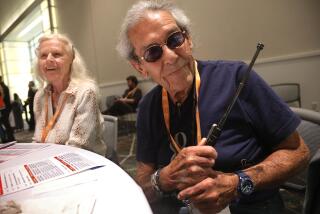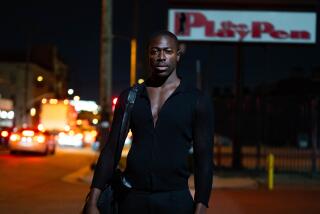Sensible Shoes, Not High Heels, Are the Choice for Working Women... : In Transit
- Share via
If you’re a working woman who started commuting via public transportation after the Northridge quake, you’ve probably realized that your footwear must change. To negotiate trains, keep your balance on a lurching bus, or even make the walk from your stop to the office without bottoming out, you need durable shoes.
When choosing a suitable commuter style, take a hint from longtime riders of the Blue Line, Metrolink, Amtrak or a bus: A quick survey of arrivals one weekday morning found a marked preference for Reeboks, followed by other brands of athletic shoes, then beat-up, comfortable flats. The sneaker-wearing women, who often put on crew socks over their hose, seemed to have an edge over their teetering counterparts in heels. They walked with a confident gait, ready to sprint to the Dash--or away from an urban predator.
Lisa Weiner commutes from Encino to a Downtown bank in the beloved floral Keds she’s had since high school. She tucks her Kenneth Cole business shoes in a tote. Carol Torres arrives Downtown in construction boots worthy of Li’l Abner, carrying her presentable high heels in a sack.
Others like to travel light and leave their work shoes under their desks. Social worker June Cowherd keeps a pair of all-purpose black pumps at the office, and executive secretary Gloria King keeps four pairs--red, black, beige and brown--to ensure color coordination.
Those who demand comfort but can’t quite get into the suit-and-sneaker combination tend to wear boots or loafers.
“I don’t wear tennis shoes,” fashionable legal assistant and Blue Line commuter Monica Singh says firmly. Her black Etienne Aigner flats make the transition from sidewalks to corridors. “Since I’ve been taking the train, I’ve been buying more flats. If it rains, I wear my Doc Martens,” she says.
Shoemakers have been considering the commuter for years, and some, including Joan Helpern of Joan & David, like to say they design for “women running through airports.” She believes in beautiful shoes that do not maim the feet.
“It’s impossible to think of anyone commuting while feeling miserable because one part of the body is in distress,” Helpern says.
“Sneakers are wonderful and comfortable,” she concedes, “but for most of us, sneakers are not the answer.”
A better solution, she suggests, is a shoe that’s “grounded in reality without being dull.” A number of styles in her current collection fit that description, including suede slippers with flexible soles. They’re available at the Joan & David company store in Century City.
New York shoe meister Kenneth Cole, who has an eponymous store on Sunset Boulevard in West Hollywood, agrees that one style can travel well from the streets to the workplace, particularly if it has rubber soles to absorb shock. “How appropriate for Los Angeles,” he says wryly of his linen boots.
Cole adds that although Los Angeles commuters tend to put their least fashionable footwear forward, many New York women take the reverse approach. “They’re a little more concerned that someone will see them coming and going,” he says. Indeed, why risk making a bad impression on a cute co-commuter?
Motorists don’t exactly have a cushy commute either. With some daily treks that have become numbingly long because of quake-related closures and detours, they want to baby their feet. Some people don slippers or driving shoes. Moccasins with pedal-gripping rubber cleats come in a range of prices: J.P. Tod’s for $170 at Neiman Marcus, Cole-Haan’s “Explorer” for $128 in the company’s Beverly Hills store or the Broadway, and Minnetonka’s for $59.95 by special order from Beverly Hills Motoring Accessories.
Other drivers simply take off their shoes. And despite rumors to the contrary, going barefoot is perfectly legal.
“I remember someone saying there was a law against driving barefoot, but that was back in the ‘70s, when I was in high school,” recalls Officer Christine Rogers of the California Highway Patrol in Sacramento. “The consensus in my office is that it’s a folk tale. There isn’t anything on the books that prohibits it.”
More to Read
Sign up for Essential California
The most important California stories and recommendations in your inbox every morning.
You may occasionally receive promotional content from the Los Angeles Times.













